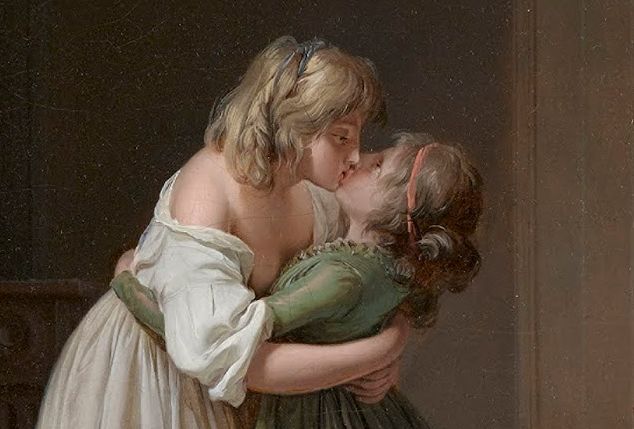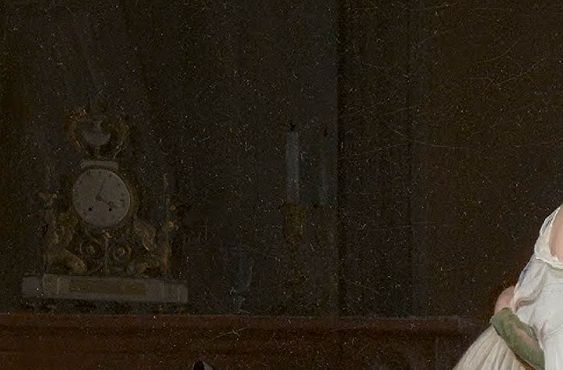Today I want to share with you all a dazzling painting by a not-so-famous French painter Louis-Léopold Boilly.
 Louis-Léopold Boilly, Deux jeunes femmes s’embrassant (Two Young Women Kissing), 1790-1794
Louis-Léopold Boilly, Deux jeunes femmes s’embrassant (Two Young Women Kissing), 1790-1794
This painting, despite being painted in the late eighteenth century, is so Rococo; naughty yet innocent, provocative yet delicate. In the age of Terror, Revolution, guillotine, rage and chopped heads, the sweet spirit of Rococo, rose-scented and dressed in cotton-candy pink is fighting to survive, fighting against the changes and the steel coldness of David and Neoclassicism. All the frivolities, intimacies and secrets from the grand canvases of Boucher and Fragonard have come alive in this simple yet delightful interior scene. Two young women are portrayed in a kiss, their arms wrapped around one another, their eyes open. The white under-dress of one girl is naughtily exposing her white shoulder and some of that cleavage. The other girl is dressed in a sumptuous green, seemingly iridescent gown. I just love how the folds and creases were painted; the shine of the fabric seems so vivid, and the fabric so tangible and crunchy. I can imagine the soft echo of it rustles down the corridor after the visit is over and the lady gone. I am assuming that the chamber belongs to the girl in white, and that the girl in green is a secret visitor, a very dear friend.
Other details in the room also bring to mind the delicate rose-perfumed interiors from the age of Madame Pompadour. Simple furniture, descending into darkness on the left half of the canvas, serves like a background on a stage for the one-act play of this sweet, short, playful kiss exchanged by two girls. A bonnet with blue ribbons, an empty glass bottle, a yellow glow, silks and a pink rose are seemingly casually placed on the little desk. On the mantle, a clock and two candles are seen. The interior is adding to the mood conveyed by the sweet kiss and all the other details around the girls are here to emphasise the softness, delicacy, and femininity. The style of the interior isn’t that Rococo, but the mood definitely is. Does it seem to me, or do I see a faint reflection of the bed in the mirror above the mantle?


Boilly (1761-1845) was popular and praised in his time, he was no stranger to portrait commissions and exhibitions, but sadly he isn’t that well remembered in the art history. His art is all but dull and boring, so the lack of talent or creativity certainty aren’t the reasons behind it. I think it has more to do with the art history’s emphasis on dates, art period, and what-influenced-what mentality. Boilly’s paintings don’t usually reflect the spirit of his times, perhaps if he had been born earlier his paintings would have been as appreciated now as those of Boucher are. Looking back on past times, an artist who doesn’t match in a dominant movement of his time is an oddball, the books don’t know where to place him so it’s easier to just ignore such an artist and focus on the ones who started a new art movement or reflected the spirit of their times in their works. I know a thing of two about being an outsider and a dreamer, so Boilly and this painting appeal to me, he was clearly portraying a dream-world in his canvases, in turbulent times, daydreaming of the past elegance that he had witness.





Leave a comment